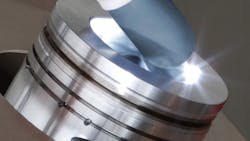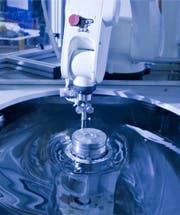Handling the Heat, and the Pressure, of New Product Development
Casting design is a demanding profession, but increasingly cast products require additional treatment after they are cast – such as custom finishing or thermal treatment. So, the design objectives for cast products require the producers to undertake more specialized efforts during casting, as well as after casting, to achieve the desired results. And, when the need involves high volumes of castings, the challenge is that much more critical.
Federal-Mogul Corp. produces pistons for engine products worldwide, so product consistency is yet another demanding objective. An area of particular attention has been developing pistons that perform well in high-performance diesel engines, where they face very high combustion pressure and operating temperatures.
Federal-Mogul's most recent introduction on this score is a coated diesel piston intended to cut frictional losses in light or heavy-duty engines. It also improves fuel economy, reduces CO2 emissions, and cuts noise and vibration. Tests showed that the new EcoTough coated diesel pistons reduced friction by up to 13% for a single cylinder engine, compared with pistons coated in conventional graphite material. The coating also has a high wear resistance that can reduce friction and fuel consumption without compromising noise and vibration standards, or the engine's durability.
"EcoTough diesel coating is part of Federal-Mogul's strategy to develop optimized piston coatings to meet the specific requirements of diesel engines," according to Dr. Frank T.H. Doernenburg, director of technology, pistons and pins. "Reducing frictional losses by applying our materials expertise is a critical element in our work with engine manufacturers."
But, the auto parts producer is focused on more than coatings. Earlier this year it introduced a new aluminum piston that offers another alternative for the high pressure and higher thermal demands of diesel engines. BMW was the first to incorporate this new piston in its N57D30S1 triple-turbo 3.0-litre diesel engine.
"Increasing the specific power output produces higher mechanical loads and temperatures, making a piston's heat dissipation as important as its strength," said Gian Maria Olivetti, vice president for technology and innovation, Powertrain Energy. "Our aluminum piston can operate efficiently under higher thermal and mechanical loads than previously possible, without the risk of engine oil cracking and carbon deposit formation associated with a steel piston. By combining all our process and materials expertise, Federal-Mogul has produced an aluminum piston with the durability and the thermal characteristics that high-power diesels require."
Note, however, that the aluminum piston is a design based on a previous development: Federal-Mogul's DuraBowl process for reinforcing the combustion bowl rim of a piston, which Doernenburg indicated debuted in 2007. The company pre-machines the cast pistons before a TIG welding robot applies a precisely defined energy input around the rim of the bowl in a single pass, to re-melt the alloy (see illustration.) The metal cools much faster than on its initial solidification (a thousand times faster, Federal-Mogul indicated), producing silicon particles that are a fraction of their original size, and enhancing the strength and durability of the alloy.
The DuraBowl Process
The DuraBowl process makes it possible for Federal-Mogul to design piston configurations that help to burn fuel more efficiently, and the greater durability of the pistons helps to reduce the product mass. Last year, it developed a piston for the large-bowl combustion chamber in Daimler's OM642 V6 3.0-litre diesel. The piston crown has an enlarged bowl recess, and steep sides with a sharp cutback below the rim that helps to reduce emissions by lowering the compression ratio (to 15.5:1 from 18:0.)
"DuraBowl extends a piston's fatigue resistance by four to eight times under cyclic thermo-mechanical loading," according senior vice president for Powertrain Energy Rainer Jueckstock.
Doernenburg explained that Federal-Mogul is producing its aluminum pistons at South Bend, IN, and a dozen other locations worldwide, using a gravity casting process similar to its technique for steel pistons — though, he emphasized that it uses a horizontal orientation during casting.
"In the diesel pistons we have a reinforcement of the first groove to reduce the wear, due to the high load," he said, "and this is a gray cast iron ring that we place into the die. This gray iron ring is usually ‘Alfin-ized' before we place it into the die," he continued.
The Alfin process is used to bond an iron insert to the location on the piston where the top piston ring groove will be machined. This is necessary because the high compression ratio of a diesel engine increases the stress on the top ring groove. Typically, the Alfin bond is an alloy of iron and aluminum, for example, FeAl3.
"We dip it (the gray iron ring) into an aluminum-silicon alloy to get a good bond between the gray cast iron and the aluminum of the piston. As molten aluminum enters the die, oxides that form around cast gray iron ring are washed away into the riser, ensuring a very good bond and a very clean piston," he detailed.
Once the aluminum pistons are cast, the DuraBowl process is used to reinforce the combustion bowl rim to withstand the high mechanical and thermal loads of diesel engines. After the aluminum alloy around the rim of the piston's combustion bowl has had its microstructure reinforced, 2D ultrasonic testing is used to ensure each piston's quality, notably the location of the Alfin ring and the effectiveness of its bond with the piston.
"The two-dimensional ultrasonic testing does several things," according to Doernenburg: "First, it measures the position of the Alfin insert and of the gallery. The gallery, especially, is very important to the (operating) temperature of the piston."
He noted that by contrast to other cast parts in a powertrain system, pistons must operate at temperatures very close to their melting temperature. "The operating temperature of the diesel piston is around 400-420°C," he pointed out, "while the melting temperature is at 480-490°C. "So the position of the Alfin insert in the gallery is one point to verify," Doernenburg noted. "The next point is to locate any oxides or porosity."
The piston gallery is used to optimize the evacuation of engine oil during operation. Doernenburg reported that the gallery is produced by placing a salt core into the die prior to casting – not a sand core — because it ensures fewer residuals in the cast metal.
The placement of the piston's raised gallery ensures that cooling oil is as close to the piston bowl as possible, to maximize cooling. "The cooler running of the piston enables durability and also reduces internal friction," said Arnd Baberg, chief engineer, Piston Product Engineering. "It is a significant design detail that will allow OEMs to introduce smaller, more efficient diesel engines that will improve fuel economy and reduce CO2 emissions."
Testing for Defects
Testing for defects is another objective. "The piston has a machined flat crown," Doernenburg detailed, "and so we send an ultrasonic beam perpendicular to the flat top into the piston, and as soon as the ultrasonic beam hits a defect, or the gallery or the Alfin, the ultrasonic beam is reflected back – and from the time it takes for the ultrasonic beam to be detected we can calculate the depth of a defect. We also measure the amplitude (or, the percentage of the beam that is reflected back) and from that we have some indication of the type, size, and position of the defect."
The piston's raised gallery places the cooling oil as close to the piston bowl as possible to achieve maximum cooling. "The cooler running of the piston enables durability and also reduces internal friction," said Arnd Baberg, chief engineer piston product engineering. "This technology will play a significant role in enabling OEMs to introduce more efficient downsized diesel engines with improved fuel economy and CO2 emissions."
The aluminum pistons were developed at the Federal-Mogul's Piston Production and Development Center in Nuremburg, Germany, but they are produced worldwide, along with the steel piston products. The group also validated the technology by dissecting and sampling hundreds of pistons, correlating ultrasonic images against destructive testing methods. That research led to the development of software tools as well as a number of physical parameters for inspection and testing finished products, such as probe geometry, wavelength, beam geometry, and focus.
Doernenburg acknowledged that producing such critical products with consistency at different locations presented challenges, but he noted that most of the operations have had long experience at casting, and that Federal-Mogul deploys a dedicated Global Plant Support to aid new product introductions. "This was developed for any new process introduction," he explained, whether it's a casting process or a surfacing process, or whatever. We manage training of the operators, and of the management teams there. After the training phase we leave them alone for a bit, and then after a couple of months we go again to see that everything is running well."
The more recent development, the EcoTough Diesel coating, continues the sequence of ongoing product development, and builds on work already done with OEMs who use an EcoTough coating for gasoline applications.
The performance of a piston is so integral to the operation of the engine that its design cannot be confined to one production step. It starts with a casting, but the result is much more demanding.
About the Author
Robert Brooks
Content Director
Robert Brooks has been a business-to-business reporter, writer, editor, and columnist for more than 20 years, specializing in the primary metal and basic manufacturing industries. His work has covered a wide range of topics, including process technology, resource development, material selection, product design, workforce development, and industrial market strategies, among others.

